Charcoal: Sumi for Furo and Ro
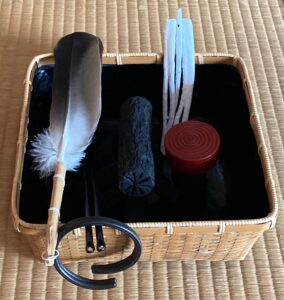
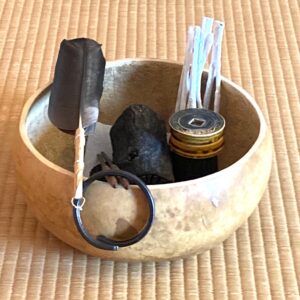
Left: sumi-tori, 炭斗, charcoal-measure, sai-rō, 菜籠, vegetable-basket, for fu-ro, 風炉, wind-hearth. Right: sumi-tori, 炭斗, charcoal-measure, fukube, 瓢, gourd, for ro, 炉, hearth.
The cha-dō-gu, 茶道具, tea-way-tools, in both sumi-tori, 炭斗, charcoal-measure, are sumi, 炭, charcoal, ha-bōki,羽箒, feather-brush, hi-bashi, 火箸, fire-rods, a pair of kan, 鐶, metal rings, kō-gō, 香合, incense-gather.
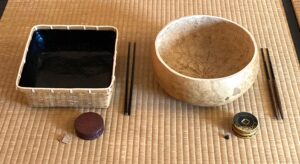
In Chanoyu, there is the critically important Ri-kyū Hyaku-shu, 利休百首, Rich-quit Hundred-necks, one hundred poems on the nature, procedures, and utensils written by Sen no Rikyū. Several of these are on the subject of sumi.
炉のうちは炭斗ふくべ柄の火箸陶器香合ねり香と知れ
Ro sumi-tori fukube e no hi-bashi tō-ki kō-gō neri-kō to shire
Hearth charcoal-measure gourd handled-fire-rods ceramic-container incense-gather knead-incense know
and:
風炉の時炭斗菜籠にかね火箸ぬり香合に白檀をたけ
Fu-ro no toki sumi-tori sai-ro kane hi-bashi nuri kō-gō ni byaku-dan wo take
Wind-hearth ’s time charcoal-measure vegetable-basket metal fire-rods lacquered incense-gather in white-sandalwood to burn.
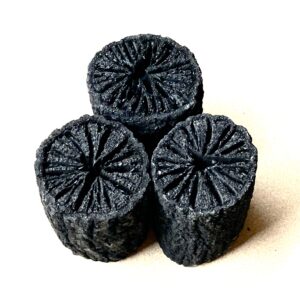
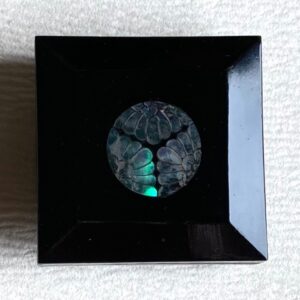
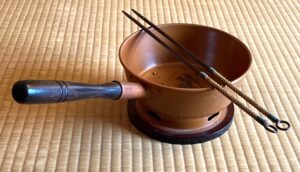
Traditionally, the shita-bi, 下火, down-fire, charcoal is heated over a fire source, and carried to the hearth in the Tearoom in a dai-jū-nō, 台十能, support-ten-skill, which is a metal pan with a wooden handle and supported on an attached wooden base. A wet towel is used to protect the hand from sparks. The charcoal is handled with a pair of mizu-ya hi-bashi, 水屋火箸, water-room fire-rods, with the handles covered in take-no-kawa, 竹の皮, bamboo-’s-skin, bound in black string.
In the word ‘tei-shu’, 亭主, house-master, the Kanji for ‘shu’ means ‘master of fire’. Before guests arrive in the Tearoom, the teishu puts incense in the hearth, shiki-kō, 敷香, spread-incense, and carries the three burning pieces of shitabi in the daijūnō, and arranges them on the incense on the ash bed of the hearth. At this moment the teishu is master of fire. When building the charcoal fire in the hearth in the presence of the guests, the teishu moves one of the burning pieces of the shita-bi, charcoal from the front of the group to the back. When first building the charcoal fire, sho-zumi, 初炭, first-charcoal, the teishu is the ‘master of fire’ in the presence of the guests.
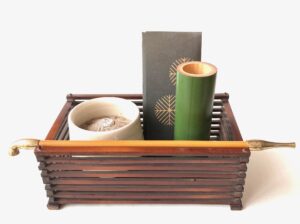
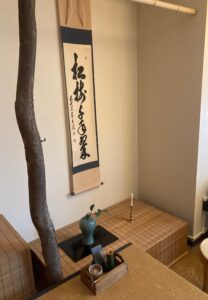
In the traditional yo-jō-han, 四畳半, four-mat-half, the tabako bon, 煙草盆, smoke-grass tray, is placed near the location of the shō-kyaku, 正客, correct-guest, who sits nearest the tokonoma. In the present time, when smoking tobacco is avoided for health reasons, the tabako bon is more symbolic than functional. The presence of the utensils alone bestows on the guest the opportunity to handle fire.
The tabako bon is placed by the teishu directly in front of the shōkyaku. After the shōkyaku holds the hi-ire, 火入, fire-receptacle, to feel the warmth of the ‘heart’ of the teishu, the shōkyaku moves the tabako bon so that is parallel with the tokonoma. In fact, the hi-ire, 火入, fire-receptacle, and the hai-fuki, 灰吹, ash-blow, containing a small amount of water, complement the hana-ire, 花入, flower-receptacle, and the rō-soku tate, 蝋燭立, wax-lamp stand, candle in the tokonoma.
![]()
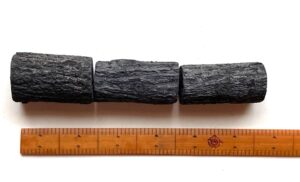
Three pieces of sumi, 炭, charcoal, when set on fire become the shita-bi, 下火, down-fire, for the furo or the ro, and are different sizes; the charcoal pictured above are for the sunken ro, 炉, hearth. Bamboo ruler: kujira–jaku, 鯨尺, whale-span.
Each piece is cut to the length of 2 sun kujira-jaku, and collectively 6 sun kujira-jaku. The charcoal for ro is cut using the kujira-jaku, whereas the charcoal for fu-ro, 風炉, wind-hearth, has the same dimension of 2 sun, but is cut using the shorter kane-jaku, 曲尺, bend-span.
The standard pieces of charcoal used in the presentation sho-zumi, 初炭, first-charcoal, are ideally cut from a single length of charcoal. The thicker pieces of charcoal are cut from the thicker base of the branch, and narrower pieces of charcoal are cut from the narrower end of the branch. The charcoal pieces for the shitabi have a relatively standard diameter.


Sumi, 炭, charcoal, for the fu-ro, 風炉, wind-hearth, measured with kane-jaku, 曲尺, bend-span (11 15⁄16 inches). The shaku, 尺, is part of a decimal system: a shaku is divided into ten sun, 寸, ‘inch’, which is divided into ten bu, 分, which is divided into ten rin, 厘.
Left photograph: three pieces of charcoal for the shita-bi, 下火, down-fire, three gitchō – each measures 2 sun which totals a length of 6 sun kane-jaku.
Right photograph: five pieces of black charcoal for the te-mae–zumi, 手前炭, hand-fore-charcoal: dōzumi, 4 sun, gitchō, 2 sun, wari-gitchō, 2 sun, kuda-zumi, 4 sun, ten-zumi, 2 sun, which is a total length 14 sun kane-jaku. 14 sun kane-jaku is the width allotted for a person on tatami in the Tearoom, for the teishu in particular, the length of the hi-shaku, 柄杓, handle-ladle, the size of the ro-buchi, 炉縁, hearth-frame, etc.
The total length of the three shitabi charcoal pieces is 6 sun kane-jaku, which is the same total length of the edazumi and two pieces of byakudan. The total length of the shitabi 6 sun kane-jaku and edazumi and byakudan, 6 sun kane-jaku is a total length of 12 sun kane-jaku. The ratio between 12 and 14 is 6:7. The number 6 is an In, 陰, Yin, negative, receptive number because it can be divided equally in half, and is symbolic of water and Infinity in Time, and the number 7 is a Yō, 陽, Yang, positive, penetrative number, and is symbolic of many things including the shi-ppō, 七宝, seven-treasures.
Shi-ppō, 七宝, seven-treasures refers to the seven kinds of treasures that appear in Buddhist scriptures: kin, 金, gold, gin, 銀, silver, ru-ri, 瑠璃, lapis lazuli, ha-ri, 玻璃, glass-glassy, quartz, crystal, shako-gai, しゃこ貝, giant clam, san-go, 珊瑚, ancestral vessel-coral, and me-nō, 瑪瑙, agate-onyx. Jewelry was made of these various metals and gems to ornament sacred images. Shi-ppō yaki, 七宝焼, seven-treasures fired, refers to cloisonné enamelware.
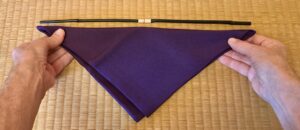
The host uses a fuku-sa, 帛紗, cloth-gauze, a silk ‘square’ to purify certain utensils. Rikyū’s fukusa measures 9 x 9.5 sun kane-jaku, which has a diagonal measurement of 13.086 sun kane-jaku. When handling and folding the fukusa, it is stretched slightly so that the diagonal from corner to corner is approximately 14 sun kane-jaku. The pictured stick measures 14 sun kane-jaku.
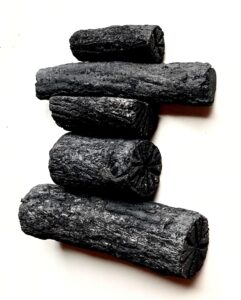
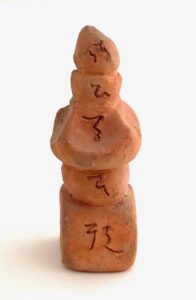
The group of 5 pieces of charcoal may be identified with the Go-rin, 五輪, Five-rings, five principles: Earth, Water, Fire, Wind, and Void. Counting the number of pieces with the unit of 2 sun kane-jaku, there are seven 2-sun kane-jaku lengths. Seven is a highly symbolic number, especially in Buddhism.
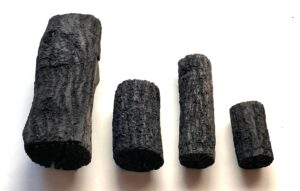
Left: ro dōzumi 4 sun kujira-jaku; ro gitchō 2 sun kujira-jaku; furo dōzumi 4 sun kane-jaku; furo gitchō 2 sun kane-jaku. The measurements for ro and furo sumi have the same numbers, but the lengths are different because they are measured with two different shaku rulers.
It is essential to have the correct lengths of charcoal, however, the diameter of the various pieces of charcoal for the ro may have, over time, become too large for practical purposes.
Sumi for furo measured in kane-jaku.
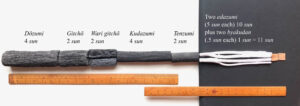
Dōzumi, 4 sun + gitchō, 2 sun + wari gitchō, 2 sun + kudazumi, 4 sun + tenzumi, 2 sun = 14 sun.
Two edazumi (5 sun each) 10 sun + two byakudan (.5 sun each) 1 sun = 11 sun. When added to the shitabi, i.e., three gitchō, 6 sun = 17 sun.
When adding the two groupings together 14 + 17 = 31 sun. There are 31 planes of existence in Buddhist cosmology, from hell to heaven.

Top row of eight pieces of sumi, 炭, charcoal, for the fu-ro, 風炉, wind-hearth; including three shita-bi, 下火, down-fire, and two small squares of byaku-dan, 白檀, sandalwood – total length of 21 sun kane-jaku.
Bottom row of ten pieces of sumi, 炭, charcoal, for the ro, 炉, hearth; including three shita-bi, 下火, down-fire, and a very small pyramid of neri-kō, 練香, knead-incense – total length of kane-jaku 26.25 sun kane-jaku. Transposed to kujira-jaku, the total length is 21 sun kujira-jaku. This is the same number, 21, as the charcoal and incense for the furo. The two lengths relate to each other 8 to 10.
The ratio between the number of pieces of charcoal for the furo and the ro is 8 to 10.
The number of ro 2-sun units for ro is 13. The number 13 may evoke the Jū-san-butsu, 十三仏, Ten-three-buddhas, which preside over thirteen periods of mourning.
![]()
A further investigation of the symbolism of the three shitabi may be found in the three animals of the San-doku, 三毒, Three-poisons or Three Fires. The Three Poisons are depicted as three animals; a pig, a snake, and a chicken. The three animals are depicted forming a circle, with one biting the tail of another. Some depictions have the animals with their heads toward the left of the circle clockwise, while other depictions show the three animals ‘moving’ to the right, counterclockwise. Perhaps moving the chicken to the other side of the group, changes the direction of movement.
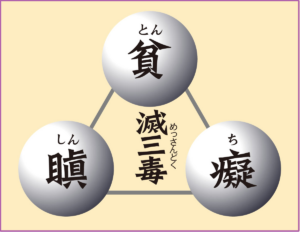
Metsu San-doku, 滅三毒, destroy Three-poisons, depicted as connecting spheres, each feeds on the others. These are the destructive aspects of human behavior that prevent us from achieving enlightenment. Hence, each aspect must be eliminated, through internal fire, like the burning of the charcoal in the hearth.
One might wonder, why the shitabi is moved. In most presentations of the building the charcoal fire, the front piece is moved to the other side of the other two pieces. Perhaps the reason is that the front piece of burning charcoal heats the ash for the placement of the dōzumi. The orientation of the three pieces is changed by moving the front piece to the back – north to south or the reverse. Or, it may be something more symbolic. Perhaps the pieces are as a group meant to be rotating, and by moving one of the three pieces, this could change the direction of the rotation.
Rotation is critical to the understanding of Buddhist doctrine. For instance, Buddha Shakyamuni is said to have ‘turned the Wheel of Dharma Three Times’ in his life. The First Turning was to propagate the scriptures of Theravada tradition, mainly the Four Noble Truths – the nature of suffering, the origin of suffering, the path leading to the cessation of suffering, and the cessation of suffering. The Second Turning primarily expounded the doctrine of emptiness or prajnaparamita. The Third Turning focused on the teaching of Tathagatagarbha or Buddha-nature.
Depictions of the Sandoku often show each as a circle or a sphere, not dissimilar to the circles of charcoal shitabi.
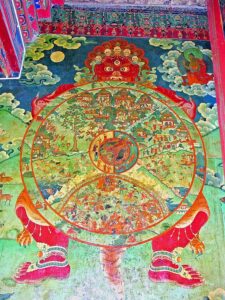
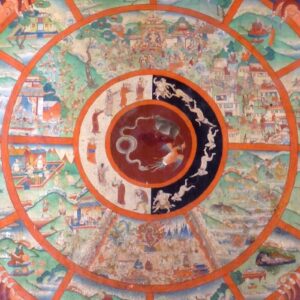
En-ma-ten, 閻魔天, Town-demon-heaven (Deva); Japanese manifestation of Yama, the King of Hell, who holds the great wheel of the Roku-dō, 六道, Six-ways.
Traditionally, the three poisons are listed as san-shu, 三種, three-kinds; Ton, Jin, Chi, which indicates the Ton/Greed is the foremost affliction of human beings. Ton, 貪, Greed – Niwatori, 鶏, Chicken; Kanji bird that scratches. Jin, 瞋, Anger, – Hebi, 蛇, Snake. Chi, 痴, Ignorance, foolishness – Buta, 豚, Pig, which in Japan is inoshishi, 猪, wild boar, which is found in the Japanese word chō-totsu, 猪突, boar-thrust, foolhardy. Through the machinations of the Sandoku the results are manifest in the Bon-nō, 煩悩, Pain-worry, worldly desires, which are collectively identified as being hyaku-hachi, 百八, 108 in number. On the Japanese New Year, temple bells are rung 108 times to dispel the Bonnō.
Illustrations of the influences of the Sandoku depict circles with radiating lines inward and outward.
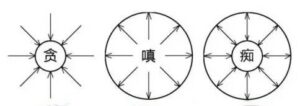
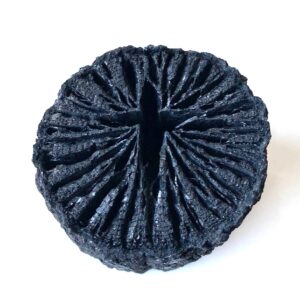
Ton: influence inward from outside. Jin: exerts influence outward. Chi: influence inward and outward. Illustrations depict influences with lines radiating outward and inward which resemble the radiating apertures in the ‘chrysanthemum’ charcoal.
There are variations in illustrations of the three animals, and which is feeding on the other. Some illustrations have the animals ‘moving’ clockwise and counter-clockwise. Curiously, although the animals feed on each other, the animals are never consumed, but are eternal. Some illustrations depict the pig feeding on the snake and chicken. As represented by the three pieces of shitabi charcoal in the hearth that are burned to ashes, their concepts are destroyed for the individual human being, but the human obsessions persist forever.
There appears to be no consistency in the colors of the three animals of the Sandoku. In Japan, the zodiac animals, the jū-ni-shi, 十二支, ten-two-branches, are depicted in iconic colors. The chicken, Tori, 酉, Chicken, is almost always depicted with white plumage. The pig, Inoshishi, 亥, Wild boar, in China is identified as a pig and is pink, however, in Japan, the animal is identified as a wild boar and is brown. The snake, Mi, 巳, Snake, is usually green, although, white snakes are revered and are associated with the goddess, Ben-zai-ten,弁財天, Discerning-treasure-heaven (deva), goddess of the arts and wisdom, goddess of the arts and wisdom. She is the Japanese incarnation of the Hindu deity Saraswati. She is the only female of the Shichi-fuku-jin, 七福神, Seven-fortune-gods.
The Japanese word for pig is buta, 豚, pig, Sus scrofa domesticus, pig rooter domestic. The Kanji, 豚, is composed of niku, 肉, flesh, and buta, shi, inoko, 豕, pig, hog, boar, sow. The Kanji for pig, 豕, is part of the Kanji for house, ie, 家, which is composed of buta, 豕, pig, under ben, 宀, roof, which has its origins in China when animals such as the pig, lived in the house. It is thought that in China, the pig was the first domesticated animal.
Hebi, 它, snake, the Kanji is composed of 宀 which is a depiction of a snake head, and 匕 is the body of a large snake.
All three of the animals are eaten in various cultures around the world. Chicken and pork are staples, whereas eating snake is somewhat rare. There are many restaurants in Japan that feature dishes made with ton/pork and tori/chicken that bear the name of a variant of Tori-Ton or Ton-Tori. The foods are often prepared on kushi, 串, skewers. A widely popular pork dish in Japan is ton-katsu, 豚カツ, pork-‘cutlet’. Snake soup has been considered a delicacy in Chinese culture for over two thousand years. A popular food in various places is snake meat barbequed on skewer; hebi no kushi-yaki, 蛇の串焼き, snake’s skewer-grilled.
![]()
The i-ro-ri, 囲炉裏, enclosed-hearth-inner, is an ancient hearth located in the floor of the main room of a house. The irori was used for heat and cooking, and is the ancient forerunner of the ro, 炉, hearth, which is set in the floor of a Tearoom. The Kanji for ro is also read irori. The familiar Kanji, 炉, is composed of ka, 火, fire, and to, 戸, door, entrance, etc. The original Kanji for ro is, 爐, which is composed of ka, 火, fire, and ro, 盧, hut; which is composed of ko, 虍, tiger, den, 田, ricefield, and sara, 皿, dish.
Identifying the ro as a ‘fire hut’ is more than poetic, because the original Chanoyu ro is constructed in the same manner as the Tea hut itself. Wattle and daub with a sand finish, suna-kabe, 砂壁, sand-wall. Each year, according to tradition, the surface of the rodan would have a fresh layer of sand on the surface.
The shitabi of three circles of charcoal may be likened to other Japanese customs, such as the ka-mon, 家紋, family-crest. One of the most familiar is based on three motifs called mitsu-domoe, 三つ巴, three-commas. This is a design that is comprised of three comma-shaped figures arranged to form a circle. Some believe it to be the representation of the threefold division of human, earth, sky at the heart of Shintoism, whereas in Buddhism, (hidari mitsu domoe) it symbolizes the cycle of life.
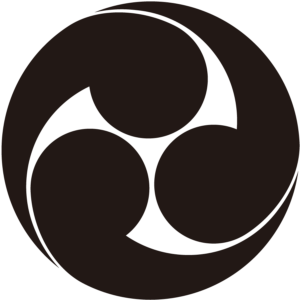
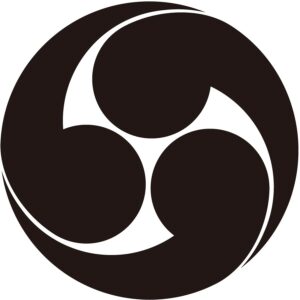
Hidari mitsu-tomoe, 左三つ巴, left three-commas, clockwise, which is contracted to hidari tomoe; migi mitsu-tomoe, 右三つ巴, right three-commas, counter clockwise, which is contracted to migi tomoe.
In a Taoist concept the symbol may be related to verse 42 of the Tao de Jing. “The Tao gives birth to One, One gives birth to Two, The Two gives birth to Three, The Three gives birth to all universal things.”
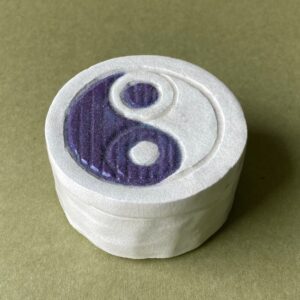
The comma motif of two commas is more commonly seen in the Taoist emblem of the Taiji, Japanese Tai-kyoku, 太極, Great-potentiality, combined In – Yō, 陰陽, Negative, receptive and Positive, penetrative.
Since it looks like water is swirling, the Kanji for tomoe, 巴, which has a similar shape, it was thought that people started carving the tomoe crest on roof tiles to prevent fires.
There are other theories that the word ‘tomoe’ originated in the maga-tama, 勾玉, curved-bead, which are said to be inhabited by lightning or divine spirits, or that tomoe is a symbol of a snake or a human soul, but there is no definitive answer for either of them.
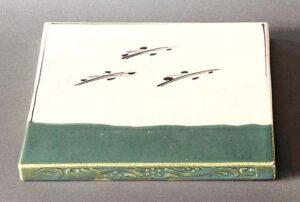

Shiki-gawara, 敷瓦, spread-tile, square, ceramic with partial green glaze, Ori-be yaki, 織部焼, Weave-guild fired, used to support a furo, that is usually made of iron, tetsu-bu-ro, 鉄風炉, iron-wind-hearth. Note the wave pattern on the side of the edge. The tile is an adaptation of a roof tile, which emulate aspects of water to metaphorically protect against fire. The wave and what appears to be a kind of flower motif, is also found on the collar, ran-kan, 欄干, rail-intercede, of the kiri-kake bu-ro, 切掛風炉, cut-hang wind-hearth.
A kama is placed on the upright koshiki, 甑, collar, which gives the appearance of a single unit.
Ceramic tiles, kawara, 瓦, tile, for Buddhist temples and palace roofs in ancient times had round end tiles with relief designs based on the hasu no hana, 蓮の花, lotus’s flower, with radiation petals. The lotus is emblematic of Buddhism. At the end of the Heian period, the end tile motif was changed to mitsu tomoe. It is thought that the comma shape was to give the appearance of nami, 波, waves, of water to ward off the fire god. Traditional Japanese temples and palaces were made of wood, which is subject to fire. Roof tiles are made to resemble waves for this very reason. The lotus is not only a Buddhist motif, but evokes water, as lotuses grow in bodies of water.
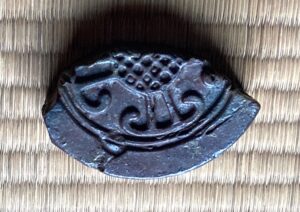
Kō-gō, 香合, incense-gather, brown ceramic covered container modeled on a roof end-tile, Bi-zen yaki, 備前焼, Provide-fore fired; L. 3 sun kane-jaku, by Ō-ae Go-rō-za-e-mon, 大饗五郎左衛門, Great-banquet Five-son-left-protect-gate, Intangible Cultural Property, In-be, 伊部, That-section.
Below: photograph of tiles used as edging in a garden. Right: tile fragments at a tsukubai, 蹲, crouching, area in a garden ro-ji, 露地, dew-ground.
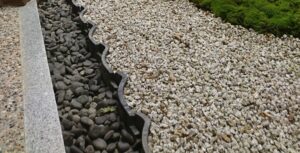
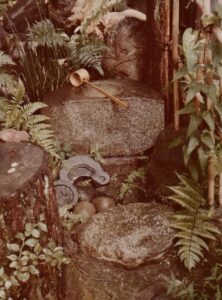
An ancient Japanese custom is using roof tiles as an edging in gardens with square or rectangular ceramic, curved or flat tiles called san-gawara, 桟瓦, pan-tile, and a most of the tile was underground, only the top part of the tile was glazed, and usually with green glaze. When such a tile is used to support a furo, the green-glazed area is regarded as shō-men, 正面, correct-face. In modern times, the tiles used in gardens are slate black, unglazed ceramic. The reason for the tile edges is keep separate ground covering, moss, or gravel, and to help keep bamboo roots from invading other areas of the garden. Fragments of roof tiles, particularly decorative end tiles, are placed in the ro-ji, 露池, dew-ground, garden, and often at the tsukubai, 蹲, crouching, area of purification. Identified with temples, the fallen tiles evoke feelings of impermanence.
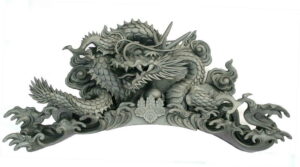
Ceramic roof tile in the form of a tatsu no oni-gawara, 龍の鬼瓦, dragon’s demon-tile, with hō-ju, 宝珠, treasure-jewel, behind the kiri-mon, 桐紋, paulownia-crest, at the bottom near the center. The dynamic and ferocious-looking dragon it to frighten away unwanted spirits, which is the purpose of the oni-gawara, 鬼瓦, demon-tile. Note the comma-form waves. Dragons bring rain, and are regarded as water creatures.
The three animals of the Sandoku may be identified with the three realms of existence: underground, on the earth, and in the air. Some snakes dig their own holes, while others occupy holes dug by other ground dwellers. Wild pigs live in muddy wallows on the ground. Because chickens are birds, the assumption is that they can fly in the air. The domesticated chicken is descended from junglefowl native to southeast Asia, and are identified as having red plumage, although the feathers are brown, and have red combs and wattles. Chickens do fly, but in a limited range, however they do roost above the ground. The Japanese word for chicken is niwatori which has its origins in niwa, 庭, which is an enclosed garden, and tori, 鳥, bird, however, the Kanji for chicken, 鶏, means the bird that scratches. The newly-hatched chick almost immediately scratches the ground looking for food or gravel.
Therefore, the snake represents underground, the pig represents the surface of the earth, and the chicken represents the air.
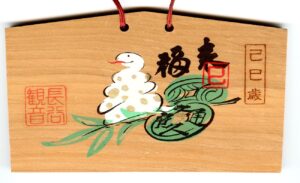
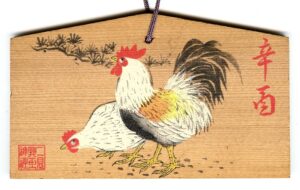
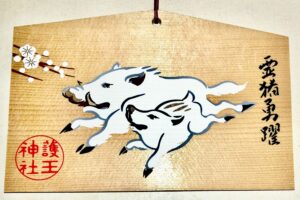
Three e-ma, 絵馬, picture-horse. From left: Mi, 巳, Snake, Ha-se Kan-non, 長谷観音, Long-valley See-sound, temple in Kamakura; Tori, 酉, Chicken, Futa-mi Oki-tama Jin-ja, 二見興玉神社, Two-see Prosper-gem God-shrine, Ise; I, 亥, Boar, Go-ō Jin-ja, 護王神社, Guard-king God-shrine. Kyōto.
E-ma, 絵馬, picture-horse, are made of wood that is cut to have go-kaku, 五角, five-corners, which has wordplay the go-kaku, 互角, mutual-corner, evenly matched, well-matched, on par with. An ema is usually placed outside of a shrine or temple, so the top of the ema is slanted like a roof gable and rain water will fall off. The measurements of ema vary greatly, however, one standard is 4 x 5 sun kane-jaku. The ratio of 4 x 5 is .8, which is a number of Infinity in Space.
Long ago in Japan, the e-ma, 絵馬, picture-horse, has its origins in the custom of offering a horse to a shrine, as the horse was believed to be a vehicle for the Shintō spirits. A horse, uma, 馬, was expensive, so, in lieu of an actual horse, a picture of a horse was offered. As time passed other images were included, such as the zodiac animal of the year, like those pictured above. Eventually the size of the ema was reduced to the general size it is to this day. Nevertheless, real horses are even now offered to shrines.
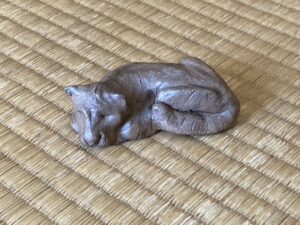
Futa-oki, 蓋置, lid-place, in the form of a sleeping tiger, unglazed stoneware, L. 3 sun kane-jaku, by Palmer, fired by Steven Murphy, Boston.
The tiger, in Japanese, tora, 虎, represents our basic passions and desires, and taking one’s place on a seat covered with such a pelt proclaims victory over the gods and demons of the illusory world of experience and cyclic rebirth. Various deities who wear or sit on tiger pelts include Lord Shiva as well as En-ma-ten, 閻魔天, Town-demon-heaven (Deva); Japanese manifestation of Yama, the King of Hell, as pictured above. The pelts of carnivorous beasts, that naturally and freely kill rather defenseless creatures, are also endowed with very special energies.
The tiger is identified with the element of Wind. The tiger bestows strength and the courage and fortitude to fearlessly overcome all obstacles. On an inner level, the wrathful, violent vibration, the karma of desires and the actual deeds performed, provide special fuel for the practioner’s inner meditative experience. In the Tibetan practice of Chod, it is the transformation of these energies, rather than avoidance of them, that is the path. The aspirant steps directly into these difficult energies and needs to develop compassion to confront their own inner demons. On the innermost level, this practice helps the meditator to cut through their hindrances.
In the ideal yojōhan tearoom, the zodiac sign of Tora, 寅, Tiger, is located in the east-northeast corner. It is joined with the zodiac sign of Ushi, 丑, Ox. Together they are identified as Ushi-Tora, with the Kanji Gon, 艮, Stopping, which is adapted from the Eki-kyō, 易経, Change-sutra. They are the guardians of the Ki-mon, 鬼門, Demon-gate, and are protected by the Buddhist deity, Ko-kū-zō Bo–satsu, 虚空蔵菩薩, Empty-void-keep Grass-buddha. This is also the location of the shō-kyaku, 正客, first-guest, of a Tea Ceremony.
For further study, see also: Furo to Ro, and Furo Ro: Three Forms

